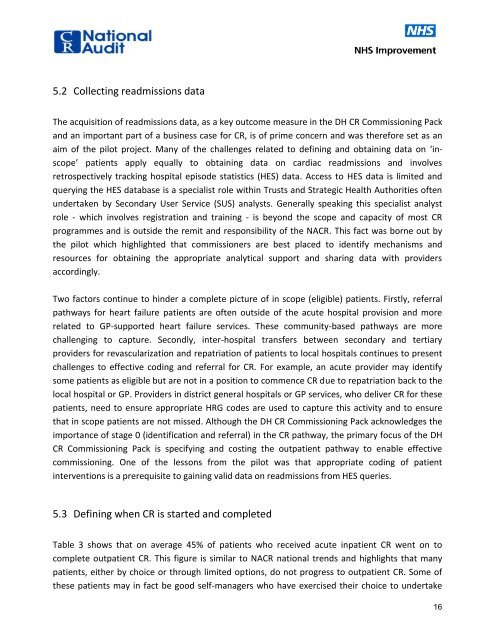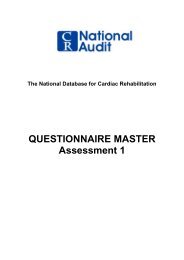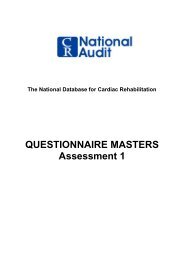DH Commissioning Pack Final Report - Cardiac Rehabilitation
DH Commissioning Pack Final Report - Cardiac Rehabilitation
DH Commissioning Pack Final Report - Cardiac Rehabilitation
You also want an ePaper? Increase the reach of your titles
YUMPU automatically turns print PDFs into web optimized ePapers that Google loves.
5.2 Collecting readmissions dataThe acquisition of readmissions data, as a key outcome measure in the <strong>DH</strong> CR <strong>Commissioning</strong> <strong>Pack</strong>and an important part of a business case for CR, is of prime concern and was therefore set as anaim of the pilot project. Many of the challenges related to defining and obtaining data on ‘inscope’patients apply equally to obtaining data on cardiac readmissions and involvesretrospectively tracking hospital episode statistics (HES) data. Access to HES data is limited andquerying the HES database is a specialist role within Trusts and Strategic Health Authorities oftenundertaken by Secondary User Service (SUS) analysts. Generally speaking this specialist analystrole - which involves registration and training - is beyond the scope and capacity of most CRprogrammes and is outside the remit and responsibility of the NACR. This fact was borne out bythe pilot which highlighted that commissioners are best placed to identify mechanisms andresources for obtaining the appropriate analytical support and sharing data with providersaccordingly.Two factors continue to hinder a complete picture of in scope (eligible) patients. Firstly, referralpathways for heart failure patients are often outside of the acute hospital provision and morerelated to GP-supported heart failure services. These community-based pathways are morechallenging to capture. Secondly, inter-hospital transfers between secondary and tertiaryproviders for revascularization and repatriation of patients to local hospitals continues to presentchallenges to effective coding and referral for CR. For example, an acute provider may identifysome patients as eligible but are not in a position to commence CR due to repatriation back to thelocal hospital or GP. Providers in district general hospitals or GP services, who deliver CR for thesepatients, need to ensure appropriate HRG codes are used to capture this activity and to ensurethat in scope patients are not missed. Although the <strong>DH</strong> CR <strong>Commissioning</strong> <strong>Pack</strong> acknowledges theimportance of stage 0 (identification and referral) in the CR pathway, the primary focus of the <strong>DH</strong>CR <strong>Commissioning</strong> <strong>Pack</strong> is specifying and costing the outpatient pathway to enable effectivecommissioning. One of the lessons from the pilot was that appropriate coding of patientinterventions is a prerequisite to gaining valid data on readmissions from HES queries.5.3 Defining when CR is started and completedTable 3 shows that on average 45% of patients who received acute inpatient CR went on tocomplete outpatient CR. This figure is similar to NACR national trends and highlights that manypatients, either by choice or through limited options, do not progress to outpatient CR. Some ofthese patients may in fact be good self-managers who have exercised their choice to undertake16





